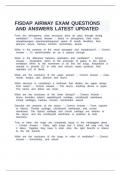FISDAP AIRWAY EXAM QUESTIONS
b b b
AND ANSWERS LATEST UPDATED
b b b b
From bcthe bcatmosphere, bcwhat bcstructures bcdoes bcair bcpass bcthrough bcduring
bcventilation? bc- bcCorrect bcAnswer bc- bcStarts bcin bcatmosphere, bcthen bcnose,
bcnasopharyngeal bcspace/orophargyneal bcspace bc(if bcmouth bcbreather), bcthen
bcpharynx, bclarynx, bctrachea, bcbronchi, bcbronchioles, bcalveoli
What bcis bcthe bcpurpose bcof bcthe bcnasal bcpassages bcand bcnasopharynx? bc- bcCorrect
bcAnswer bc- bcTo bcwarm/humidify bcair bcas bcit bcpasses bcthrough
What bcis bcthe bcdifference bcbetween bcrespiration bcand bcventilation? bc- bcCorrect
bcAnswer bc- bcRespiration bcrefers bcto bcthe bcexchange bcof bcgases bcin bcthe bcalveoli,
bcventilation bcrefers bcto bcthe bcmovement bcof bcair bcinto bcthe bclungs. bcRespiration bcis
bcneeded bcto bcprovide bcO2 bcto bccells bcand bcremove bcwaste bcproducts. bcAlso
bcregulates bcpH bcof bcblood.
What bcare bcthe bcstructures bcof bcthe bcupper bcairway? bc- bcCorrect bcAnswer bc- bcnose,
bcmouth, bctongue, bcjaw, bcpharynx bcand bclarynx
What bcstructure bcis bcconsidered bca bclandmark bcthat bcdivides bcthe bcupper bcairway
bcfrom bclower? bc- bcCorrect bcAnswer bc- bcThe bclarynx, bcanything bcabove bcis bcupper.
bcThe bclarynx bcand bcbelow bcare bclower.
What bcare bcthe bcstructures bcof bcthe bclower bcairways? bc- bcCorrect bcAnswer bc-
bclarynx bc(includes bcadam's bcapple/thyroid bccartilage, bccricothyroid bcmembrane,
bccricoid bccartilage), bctrachea, bcbronchi, bcbronchioles, bcalveoli
Describe bcthe bcanatomy bcof bcthe bclarynx. bc- bcCorrect bcAnswer bc- bcFrom bcsuperior
bcto bcinferior. bcThyroid bccartilage, bccricothyroid bcmembrane, bcand bccricoid
bcmembrane. bcThe bcthyroid bccartilage bcand bccricoid bccartilage bcare bcanterior bcto
bcthe bclarynx, bcand bcthe bccricothyroid bcmembrane bcis bcposterior bcto bcboth
bcstructures.
True bcor bcfalse: bcthe bclungs bcare bccompletely bcequal bcin bcthe bcmidsaggital bcplane.
bc- bcCorrect bcAnswer bc- bcFalse, bcright bclungs bchas bc3 bclobes, bcleft bclung bconly bchas
bc2 bclobes. bcTogether bcthey bchave bc5 bctotal. bcAlso, bcthe bcright bcbronchi bcis bcinferior
bcto bcthe bcleft bcbronchi.
What bcare bcthe bcstructures bcof bcthe bclungs bcin bcorder bcof bcventilation? bc- bcCorrect
bcAnswer bc- bcbronchioles, bcand bcalveoli
,True bcor bcfalse: bcthe bclungs bcuse bcmuscles bcfound bcin bcthe bclateral bclobes bcto
bcexpand bcand bccontract? bc- bcCorrect bcAnswer bc- bcFalse: bcthe bclungs bcare bchollow
bcorgans bcand bccontain bcno bcmuscles. bcWhen bcthe bcdiaphragm bccontracts bcit
bcexpands bcthe bcthoracic bccavity. bcThe bcpleural bcspace bchas bca bcnegative bcpressure
bcand bcthe bclungs bcexpand. bcThis bcresults bcin bca bcslightly bcnegative bcpressure
bc(compared bcto bcthe bcatmosphere) bcand bcair bcrushes bcin.
True bcor bcfalse: bcAir bcrushes bcinto bcthe bclungs bcbecause bcof bcnegative bcpressure.
bc- bcCorrect bcAnswer bc- bcTrue, bcwhen bcthe bclungs bcexpand, bcthey bcare bccreating bca
bcvacuum bcbecause bcthey bcare bcexpanding bcthe bcvolume bcof bcthe bccontainer. bcThis
bcincrease bcin bcvolume bccauses bcinflux bcof bcair bcinto bcthe bccontainer bcuntil bcthe
bcpressure bcis bcequalized bcwith bcthe bcatmosphere.
True bcor bcfalse: bcThe bcparietal bcpleura bclines bcthe bclungs bcand bcthe bcvisceral
bcpleura bclines bcthe bclungs. bcThe bcspace bcbetween bcis bccalled bcthe bcanterior
bcpleura. bc- bcCorrect bcAnswer bc- bcFalse: bcthe bcvisceral bcpleura bclines bcthe bclungs,
bcthe bcparietal bcpleura bclines bcthe bcbody bccavity bcand bcthe bcpleural bcspace bcis bcthe
bcspace bcin bcbetween bcboth bcwhere bcbody bcfluid bcallows bcfor bcboth bcto bcsmoothly
bcglide.
What bcmuscles bcare bcinvolved bcin bcinhalation? bc- bcCorrect bcAnswer bc- bcThe
bcdiaphragm, bccervical bcmuscles bc(neck), bcintercostals, bcabdominal bcmuscles, bcand
bcpectoral bcmuscles.
What bcmuscles bcare bcinvolved bcin bcexpiration? bc- bcCorrect bcAnswer bc- bcnone,
bcexpiration bc(if bcdone bcpassively) bcis bcachieved bcby bcthe bcrelaxation bcof bcthe
bcdiaphragm.
What bcis bcthe bcprimary bcdriver bcof bcrespiration? bc(Why bcwould bcwe
bcincrease/decrease bcRR?) bc- bcCorrect bcAnswer bc- bcThe bcCSF bcin bcthe bcbrain bchas
bcchemoreceptors bcsensitive bcto bcCO2. bcWhen bcthere bcis bctoo bcmuch bcCO2. bcThe
bcpH bcchanges. bcThese bcsensors bcfeed bcback bcto bcthe bcmedulla bcoblongata, bcwhich
bcstimulates bcthe bcphrenic bcnerve bcwhich bcinnervates bcthe bcdiaphragm. bcThey
bccause bcan bcincrease bcin bcactivity bcof bcthe bcdiaphragm. bcThis bcincreases bcthe bcRR
bcwhich bccauses bcus bcto bcincrease bctidal bcvolume. bcThis bcmeans bcmore bcCO2 bcis
bcexhaled. bcAnd bcbrings bcour bcpH bcback bcto bcnormal.
We bcalso bchave bcthe bcless bcsensitive bchypoxic bcdrive
What bcis bchypoxic bcdrive? bc- bcCorrect bcAnswer bc- bcBackup bcsystem bcto bccontrol
bcrespiration. bcChemoreceptors bcin bcbrain, bcaorta, bcand bccarotid bcarteries. bcBut bcthey
bcare bc"satisfied" bcby bca bcsmall bcamount bcof bcO2, bcwhich bcmeans bcit bcis bcnot bcas
bcsensitive bcas bcpH bccontrol bcof bcCO2
, What bctwo bcareas bcof bcthe bcbrain bcare bcinvolved bcin bcrespiration? bc- bcCorrect
bcAnswer bc- bcmedulla-controls bcrhythm, bcinitiates bcinspiration, bcsets bcbase bcpattern
bcfor bcrespirations, bcand bcstimulates bcdiaphragm bcto bccontract.
pons-changes bcdepth bcof bcinspiration, bcexpiration bcor bcboth.
True bcor bcfalse: bcarteries bcbring bcoxygenated bcblood bcto bcorgans/capillaries bc-
bcCorrect bcAnswer bc- bcTrue bcin bcmost bccases bcwith bcone bcexception. bcArteries
bc(away) bcbring bcblood bcaway bcfrom bcthe bcheart. bcUsually bcthis bcis bcoxygenated
bcblood. bcBut bcthe bcpulmonary bcarteries bcbring bcoxygen bcpoor bcblood bcaway bcfrom
bcthe bcheart, bcto bcthe bclungs bcto bcbe bcoxygenated.
What bcis bcthe bctidal bcvolume? bc- bcCorrect bcAnswer bc- bcamount bcof bcair bcmoved
bcin/out bcof bclungs bcin bcsingle bcbreath. bcUsually bc500 bcml bcin bcadult
What bcis bcinspiratory bcreserve bcvolume? bc- bcCorrect bcAnswer bc- bcDeepest bcbreath
bcyou bccan bctake bcafter bcnormal bcrespiration
What bcis bcexpiratory bcreserve bcvolume/Vital bcCapacity? bc- bcCorrect bcAnswer bc-
bcmaximum bcamount bcyou bccan bcbreathe bcout bcafter bcnormal bcbreath.
What bcis bcresidual bcvolume? bc- bcCorrect bcAnswer bc- bcRemaining bcgas bcin bclungs
bcafter bcexhalation. bcThis bcis bcto bckeep bclungs bcinflated
What bcis bcdead bcspace? bcWhat bcstructures bcare bcconsidered bcpart bcof bcdead
bcspace? bc- bcCorrect bcAnswer bc- bcPart bcof bcrespiratory bcsystem bcnot bcinvolved bcin
bcactive bcrespiration. bcAir bcmoves bcthrough bchere bcbut bclittle bcto bcno bcrespiration
bcoccurs. bcMouth, bctrachea, bcbronchi bcand bcbronchioles bcconsidered bcdead bcspace
What bcis bcminute bcvolume? bcWhat bcdoes bcit bcmeasure? bc- bcCorrect bcAnswer bc-
bcMinute bcvolume bc= bcRR bcx bctidal bcvolume. bcVolume bcof bcair bcmoving bcthrough
bclungs bcin bc1 bcminute. bcCan bcbe bcestimated bcquickly. bcCount bcRR bcrate. bcIf
bcnormal bccheck bcto bcsee bcchest bcrise bcand bcfall bc(tidal bcvolume). bcIf bcchest bcrise
bcand bcfall bcis bcweak bcand/or bclittle bcair bccoming bcout bcof bcnose, bcthen bcthe bcperson
bchas bcsmall bcminute bcvolume.
Alveolar bcMinute bcVolume bc- bcCorrect bcAnswer bc- bcVolume bcof bcair bcmoved
bcthrough bclungs bcin bc1 bcminute bcminus bcthe bcdead bcspace. bcAlveolar bcMinute
bcVolume bc= bc(tidal bcvolume bc- bcdead bcspace) bcx bcRR
Alveolar bcVentilation bc- bcCorrect bcAnswer bc- bcVolume bcof bcair bcthat bcreaches
bcalveoli.
Alveolar bcventilation bc= bctidal bcvolume bc- bcdead bcspace




